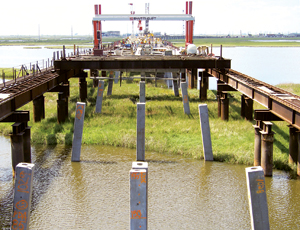If a hurricane hits southern Louisiana this year, a critical portion of the roadway that carries almost 20% of the nation’s total oil supply from the Gulf of Mexico should remain high and dry.
The Louisiana Dept. of Transportation and Development on July 7 plans to open the first 4.4 miles of the new Louisiana Highway 1. The eventual 18-mile, 26-ft-high, four-lane elevated route between Golden Meadow and Port Fourchon will replace the existing, flood-prone La. 1 that is slowly sinking.

A joint venture of Traylor Bros. Construction, Evansville, Ind., and Massman Construction Co., Kansas City, holds both a $141.1-million contract to construct connector ramps and approaches and a $20.2-million contract to construct the 350-ft-long steel-girder span with a 73-ft-high clearance over Bayou Lafourche. DOTD will re-route traffic from an old vertical lift bridge, which “is susceptible to maintenance issues and reliability issues, as well as scour from flooding,” says Tony Ducote, DOTD project management director.
When demolition of the old lift bridge begins, the new portion will be the sole access route to the port and area communities. The road is completely fitted with electronic open-road tolling, a first for Louisiana. DOTD hired Wilbur Smith and Associates, Columbia, S.C., to conduct a public outreach campaign about tolling. “Even though people were overwhelmingly in support of tolling three or four years ago, when you actually implement it you want as few glitches as possible,” Ducote says. Tolling begins at the end of July, when E.P. Breaux Electrical Inc., New Iberia, La., completes its $8- million contract.
Wilbur Smith hired HNTB Corp., Kansas City, to conduct public meetings throughout the state about how the system works and where to register for a toll tag. “Outreach is a little different here in that La. 1 services three distinct constituencies: permanent residents of Grand Isle and Port Fourchon, tourists and camp owners who are frequent visitors and the business industry of Port Fourchon,” says Bryan Jones, an HNTB senior public involvement representative. “Here we’ve got such a rural area with a diverse population that includes multibillion-dollar businesses with hundreds of fleets of trucks and Grandpa Jones in his old pickup truck who has been going down there for 70 years to go fishing.”
HNTB’s Baton Rouge office partnered with its New York City architecture office to design a customer service center with the functionality of a drive-through bank and 24-hour kiosks to purchase toll passes, says Steven Skeele, HNTB engineer. The center is built to hurricane codes and has a circular drive to accommodate six-axle trucks.
James Construction Group, Baton Rouge, has completed about 30% of its $137.5-million contract to construct six miles of elevated roadway from Port Fourchon to Leeville, tying in with the Traylor/Massman portion. It is using a 1,560-ft-long steel trestle supported by temporary pipe piles and fitted with two gantry cranes that traverse it. “This is the first one...like this in Louisiana, other than the Interstate 310 interchange built several years ago by this company’s predecessor, T.L. James Construction,” says Danny Hester, JCG’s chief operating officer. “Because we are over the marshes, an ecologically sensitive area, we can’t get on the ground to build the bridge.”
The trestle is supported by 90-ft x 30-in. steel-pipe piles. With a crane positioned on the trestle platform, JCG drives permanent precast 24-in.-wide piles, sets the precast caps and girders, and pours the decks. The temporary pipe piles are extracted as the operation moves forward. The project is slated for completion in 2011.
Phase 2, an 8.3-mile stretch of bridge from Leeville to Golden Meadow, is in preliminary engineering, Ducote says. However, “we have no money for the construction portion of Phase 2,” he says.

Post a comment to this article
Report Abusive Comment